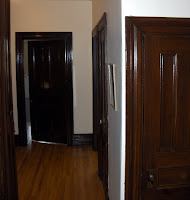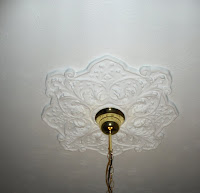












When it comes to choosing a ceiling product for your basement rec room, there are two basic choices — drywall and suspended. Most people prefer the look of smooth drywall, and I understand that — it’s relatively easy to install and looks great. It’s hard to argue with the elegance and simplicity of a perfectly flat, drywalled ceiling. Suspended ceilings look ’seventies’ to many people, or institutional. But I think they more people should consider using them.
Depending on the height of your basement, you may be limited to one type or the other, so let’s start with assessing your basement, to get an idea of which way you should go. The distance between the basement floor and the bottom of the floor joist overhead will be the big deciding factor. That’s all about how much headroom you have — or how much you can afford to lose. Drywall can be fixed directly to the joists, so you only lose a half an inch of headroom — the thickness of the material. With suspended systems, you can lose about 3-5 inches.
If you have a new home, the basement usually is deep enough and ceiling height usually isn’t a concern, so you have your choice. But in the case of an older home, the basement was thought of as a utility area, not as living space. So the room height isn’t necessarily going to be great.
In this case you’ll need to maximize the headroom, so drywall might seem the best or only option. But be warned: if there are electrical junction boxes in between the joists, you can’t permanently cover these over with drywall. That’s dangerous and against code.
So, you will need to have your wiring updated and those junction boxes moved. That’s going to add to your reno budget.
Also, in some older homes I find there are many times where copper piping or ductwork is attached to the bottom of joists, making it impossible to hang drywall directly to the bottom of the joists.
This situation is exactly why I’m a fan of a suspended system. It always gives you easy access to all the electrical and plumbing in your ceiling. It’s practical. And, to my mind, the disadvantage of losing a couple of inches of headroom is worth the access convenience. Suspended panels can also be replaced easily in the event of a plumbing leak from above, or long-term condensation damage from sweating pipes.
To me it’s a no-brainer that, given the choice, a suspended ceiling is the way to go. But if those institutional-looking two by four foot foam rectangles we are so used to seeing in commercial buildings are putting you off, you need to know there are new ceiling systems that look stylish. Or, your contractor can simply cut the panels into 2 by 2 foot sections to get away from that school or office look.
Another factor to consider is the acoustic properties of the space. Are you going to have your TV with surround sound speakers in the basement? Some suspended ceilings are made of soft, sound absorbing material so that it minimizes sound deflection or echo in the room. It makes a noticeable difference, especially if the floor isn’t carpeted. And, back to practical reasons — running speaker wires for a 5.1 surround sound system is easy with a suspended ceiling, and that goes for a basement installation, or even for running wires for a TV room on the floor above. It is not nearly as straightforward and clean with a finished drywall ceiling.
As far as sound proofing qualities, both drywall and suspended ceilings can have equal amounts. Drywall can be mounted on resilient channels that separate the drywall from the floor joists and minimize the transfer of certain frequencies. But the trade-off is a thicker ceiling. You can also get special soundproof drywall sheets. Because suspended ceilings already have a resilient property built in, and has a sound absorbing feature to minimize sound deflection, I would go with the suspended ceiling if overall acoustics, as well as soundproofing are important to your environment.
The important thing to remember when choosing a ceiling system is to make your decision based on practical reasons and not strictly based on looks. Ask yourself these questions:
Do I need to maximize the headroom?
Do I have electric junction boxes between the joists?
Are there obstructions hanging down below the bottom edge of the joists?
Am I going to need access behind the ceiling in the future?
It may be that you have HVAC ductwork hanging down low in certain places. Maybe your situation requires more than one type of ceiling system, such as drywall around your ducts and a suspended ceiling across the flat expanse. The trick is to make the best decisions directly based on the situation and the obstacles already in place.
Dave - 360renos


But you're crushed when you see the small, outdated kitchen and walk away from the almost-dream property, only to repeat the process again and again.
"You come in, you don't like the kitchen, you're going to waste all this time going looking at other homes when this might be the perfect house," says Laura Parsons, a mortgage specialist at the Bank of Montreal (TSX:BMO).
Canadians feeling a sense of urgency to buy while mortgage rates are low are more likely to engage in bidding wars and overspend or panic and settle for something that doesn't meet their needs, Parsons says.
" It's created some excitement in the market and our prices are going up so most Canadians are feeling the pressure: 'Oh my goodness, if I don't get in now, what does the future look like?"' But it doesn't have to be that way - and one alternative is to buy a fixer-upper for an excellent price and have it customized by the time you move in.
Purchase-plus-improvement mortgages can allow qualified purchasers to borrow additional money from a mortgage lender to pay for those renovations. Under the plan, a lender takes into account the improvements made by the new owner and gives credit based on the increased value of the property.
Gary Siegle, a regional manager at mortgage brokerage firm Invis Inc., says the program is suited to buyers willing to "look beyond the bruises" and visualize how renovations could transform houses that are often underpriced because they need work.
"People who are looking at this are people who are saying 'the house I really want is not currently available or it's overpriced, so here's another option, I can buy a house that's the right floor plan and it's not going to take a lot of work to make it look like the home I was really hoping to get'." There's another option for homeowners who want to take advantage of low rates, but avoid the stress of relocating, Siegle says. They can refinance a mortgage to include the cost of renovations or use equity in the home they already own to secure a line of credit.
Garages, bathrooms and kitchens usually give homeowners the biggest return on their investment but a purchase-plus-improvement mortgage can also be used for anything that adds value to a home.
The plan also benefit sellers who don't want to waste time and money on renovations before they put their home on the market for someone else to love or hate.
Instead, sellers may want to make the buyer aware of the option and then negotiate based on time instead of price, with the seller offering to be flexible about allowing the buyer to start upgrades while they're still living in the home.
Siegle says its important to remember that buyers still have to pay for the renovations up front with a credit card or savings but will be reimbursed when the renovations are complete. That can be a challenge for buyers with limited funds.
This is how a purchase plus improvement mortgage works step by step: Step 1: Shop around for the best rate on a mortgage pre-approval, which will provide a clear price range.
Step 2: Put in an offer on the fixer-upper, making sure it's clear the bid is subject to appraisals, inspections and the cost of renovations.
Step 3: Have the home appraised for its "as-is" value, as well as a projection of what it would be worth post-renovations. Also have the home inspected to make sure there are no hidden additional costs.
Step 4: Get written cost estimates from contractors on upgrades. Take the best estimate to the lender.
Step 3: Apply for a mortgage that includes the cost of upgrades. If a home is appraised at $400,000 but requires $50,000 worth of renovations, buyers would secure a mortgage for $450,000, in addition to the minimum five per cent down payment.
Step 4: If the mortgage is approved, close the offer with the seller. The funds for renovations will be sent to your lawyer "in trust" when the mortgage closes.
Step 5: Upgrades, paid for up front by the buyer. Depending on the extent of the work that needs to be done, it could add weeks or months to the move-in date.
Step 6: Renovations are complete. Funding, which has been held back by a lawyer until the work is completed and inspected, is released and the contractor can be paid. If the renovation is more extensive and costly than just cosmetic changes, the advances are staged, meaning buyers receive them in stages as work progresses.
